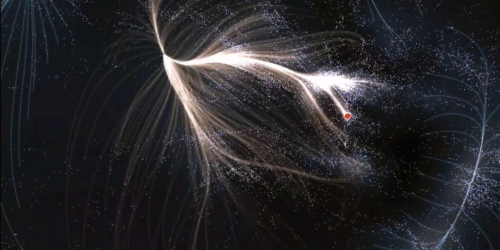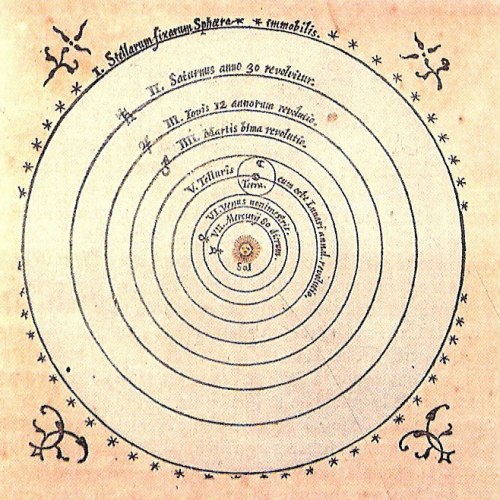The stars are nice and the planets are nice.*
— Scott Williams, Stanford Research Institute
When Copernicus showed that the Earth orbits the sun, his heliocentric model of the cosmos placed our local star not only in the middle of the solar system but at the center of the universe itself. The error is revealing. The astronomer may have knocked mankind from its Earthly pedestal, but he warded off an even more profound displacement with his compact and orderly vision of concentric heavenly bodies. This Copernican double movement of decentering and recentering is typical of scientific knowledge, if not of human knowledge as a whole.
Copernicus comes to mind when one considers the announcement last week of the discovery of Laniakea, the enormous galactic supercluster that contains Earth’s galaxy. “Say Hello to Milky Way’s New Home,” said a headline in the Tech Times; “Welcome to Laniakea, our Galactic Home,” said another. Nature magazine announced “Earth’s New Address,” and the Daily Beast touted “The Milky Way’s Place in the Heavens.” The articles’ cheerful tone and their stubborn insistence on the idea of “home” betray the literally domesticating impulse in cosmological understanding. It seems that no earth-shaking discovery is so disorienting that can’t be made familiar, friendly and reassuringly divine. Unsurprisingly, the name given to the supercluster puts a comforting metaphysical stamp on the cosmic discovery: Laniakea, derived from the Hawaiian language, means “immense” or “immeasurable heaven.”

At least one commentator has pointed out that the name “immeasurable heaven” is unwittingly ironic, given that, as he says, “measuring it is exactly what we’re doing.” But one despairs at a grasp of “irony” that can invoke exactitude when referring to measurements on such a vast scale, or that blithely wields an interpellating “we,” the journalist’s casual shorthand, presumably, for “our common humanity.” Still, no commentator is immune from a genuine sense of wonder and amazement at the magnitude of the cosmic discovery. This, however, becomes the occasion for a kind of ritual of self-debasement in the press that is quickly converted into a posture of mastery. As the Slate columnist puts it, “Astronomy is both ennobling and humbling. It tells us our place in the Universe, which can make you feel small … but don’t forget that we’re a part of that Universe, and the fact that we can figure this stuff out at all makes us very big indeed.” Geek magazine echoes this symptomatic disavowal of human tininess by first invoking the “unknowable” only to follow it up with a reference to man’s intelligence, which the columnist imagines as mirrored by a similar species aping our own actions “from the other side.”
“It’s amazing to think that Laniakea is just one of many superclusters…. It contains (literally) quadrillions of stars and an unknowable number of planets. Maybe somewhere out there is another intelligent species looking out into space and mapping the same supercluster from the other side.”
The size of Laniakea beggars the mind, and writing about it surely calls for some minimal verbal compunction. After all, when speaking of a place some 520 million light-years away — the “other side” of the supercluster — how can one plausibly use the present verb tense, as if humans shared the same ontological time as beings among those faint faraway lights, many of which are ghostly afterimages of worlds that no longer exist? Laniakea throws the human scale of space and time utterly out of operation. Our frail, earthly meaning-making loses all relevant context and perspective. One might think the encounter with such cosmic enormity would provoke an experience of the sublime.
Immanuel Kant’s Critique of Judgment offers the most compelling and influential account of sublime experience. When confronted with a spectacle of overwhelming natural grandeur, Kant says that the observing mind takes stock of the imagination’s incapacity to fully render it in an adequate image. The experience is painful, Kant says, as it demeans the mind and makes it realize its powerlessness. But as it turns out, the failure of the imagination engenders a victory of the mind, since the latter, he says, can go so far as to conceive of the infinite, even if it cannot picture it. In his account of sublime experience, then, Kant leads us to the very limits of what can be humanly represented and conceived, but at that perilous brink the philosopher rediscovers a quasi-divine force of “supersensible” intuition that rescues the mind from its mortifying sense of impotence.
Kant the polymath also authored a Universal Theory of the Heavens, which, drawing on the work of contemporary astronomers, speculated on the the puzzling “nebula” formations readily visible from Earth. The general belief in the mid-18th century was that nebulae such as Andromeda, which the philosopher called “island universes,” formed part of our own Milky Way. It wasn’t until the 1920’s that the Andromeda “cloud” was conclusively proven to be a separate galaxy far outside the Milky Way and twice its size as well. Since then the number of recognized galaxies has grown at an exponential rate. In 1995 the Hubble Space Telescope peered deep into an apparently empty speck of sky and discovered no less than 3,000 previously unknown galaxies. Some 100,000 galaxies are encompassed by the Laniakea supercluster alone, but this is only a tiny fraction of the universe’s estimated total of 125 billion galaxies.
Critics have faulted Kant for refusing to own up to human finitude in the text where he explores it so well, and the stakes of Kant’s failure are more pressing than ever in a time of inflationary sublimity. Indeed, pedestrian cosmologists seem to enact in their own way a Kantian recoil from the evidence of the senses. Kant has been accused of propping philosophical critique on illusions of spiritual mastery, and Jean-François Lyotard has suggested that “The Analytic of the Sublime” could be taken as the staging of “a philosophical neurosis.”** In an effort to reclaim the most radical aspects of Kant’s text, Lyotard has argued that certain extreme experiences should be thought of as defying representation. However, in a biting critique titled “Are Some Things Unrepresentable?” Jacques Rancière scorns Lyotard’s claims as imposing on the visual arts a sanctimonious and quasi-religious ban on images in the face of “holy terror.”*** Such a ban logically implies a dictatorial notion of appropriate forms of representation, Rancière argues, and he sarcastically asserts that “this idea is vacuous” (137). But what, we might ask, is the idea of the vacuous? Is there, in Kantian terms, a representation adequate to sheer vacuity — say, the empty interstellar space comprising a mere atom per square meter? Can we form an idea or even an image of the “cosmic void” over which the earth is apparently perched, clinging to the tip of a near-infinite strand of filaments at the far reaches of Laniakea?
* Stuart Clark, “Are Elon Musk’s ‘megaconstellations’ a blight on the night sky?” The Guardian, 12 September 2020.
** Jean-François Lyotard, Lessons on the Analytic of the Sublime, 150.
*** Jacques Rancière, “Are Some Things Unrepresentable?” In The Future of the Image.

